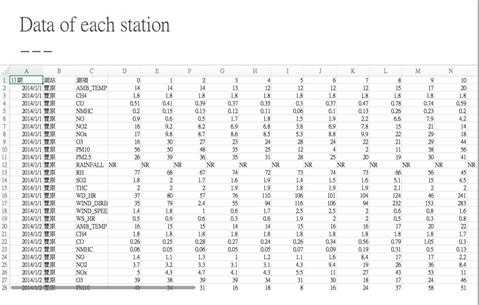标签:个数 pen 扯淡 error ddc writer val gif 学习
话说学机器学习,不写代码就太扯淡了。好了,接着上一次的线性回归作业。
hw1作业的链接在这: http://speech.ee.ntu.edu.tw/~tlkagk/courses/ML_2016/Lecture/hw1.pdf
作业是预测台湾的PM2.5的指数,既然是回归问题,肯定是用的是上一节课的线性回归了。


以上数据我传到https://pan.baidu.com/s/1dFhwT13 上面了,供有兴趣的人做做。
实际上上述中分为训练数据和测试数据,都是CSV格式的,而且只用到PM2.5有用,其他的没什么用,同时通过测试数据才知道,
其实就是用前9个小时的PM2.5数据作为特征,来预测第10个小时的数据,将第10个小时的数据保存为csv格式,作为预测结果。
好了,不多说,上代码。我的开发环境还是win7+pycharm4.0
第一步,读取train.csv. 获取PM2.5的训练数据 ,一共240个训练数据,将前9个小时的数据作为特征,将第10个小时的数据作为标签
 View Code
View Code第二步,利用梯度下降来训练权值和偏置。
 View Code
View Code第三步,测试训练集。这个可以不需要,是我调试过程中看,对训练集的预测精度怎么样?
 View Code
View Code第四步,运行测试集,并保存测试结果。
首先读取测试集的数据,和训练集一样
 View Code
View Code保存预测结果到csv文件中:
 View Code
View Code
完整的程序:
1 # -*- coding:UTF-8 -*-
2 __author__ = ‘tao‘
3
4 import csv
5 import cv2
6 import sys
7 import numpy as np
8 import math
9
10 filename = ‘F:/台湾机器学习/data/train.csv‘
11 ufilename = unicode(filename , "utf8") #这一块主要是因为汉字路径 也就是python调用open打开文件时,其路径必须要转换为utf-8格式
12 list=[]
13 result=[]
14 row=0
15 colum=0;
16 with open(ufilename, ‘r‘) as f:
17 data = f.readlines() #dat中所有字符串读入data
18 for line in data:
19 odom = line.split(‘,‘) #将单个数据分隔开存好
20 colum=len(odom)
21 if ‘PM2.5‘in odom:
22 lists= map(int, odom[3:12])#第三个开始开始数据 一直取9个数
23 results= map(int, odom[12:13])#取第10个数
24 list.append(lists)
25 result.append(results)
26 # print odom
27 row=row+1
28
29 #print("原始数据是:{0}行 :{1}列 的数据".format(row, colum))
30 print("有{0}个训练数据".format(len(list)))
31
32
33 #y=w0*x0+w1*x1+w2*x2+w3*x3+w4*x4+w5*x5+w6*x6+w7*x7+w8*x8+b0
34 #
35
36 alpha=0.0001
37 b_0=np.random.rand(1,1)
38 th_0 = np.random.rand(1,1);
39 th_1 = np.random.rand(1,1);
40 th_2 = np.random.rand(1,1);
41 th_3 = np.random.rand(1,1);
42 th_4= np.random.rand(1,1);
43 th_5 = np.random.rand(1,1);
44 th_6 = np.random.rand(1,1);
45 th_7 = np.random.rand(1,1);
46 th_8 = np.random.rand(1,1);
47 for k in range(1000):
48 length = len(list)
49 jtheta = 0
50 total = 0
51 sum_total = 0
52 for id in range(length):
53 # print("当前序号{0}训练数据".format(id))
54 xset= np.array(list[id]) #一行 X数值
55 yset= np.array(result[id]) # 要估计值
56 total = total + b_0 + th_0 * xset[0]+ th_1 * xset[1]+ th_2 * xset[2]+ th_3 * xset[3]+ th_4 * xset[4]+ th_5 * xset[5]+ th_6 * xset[6]+ th_7 * xset[7]+ th_8 * xset[8]- yset
57 # print( "当前误差{0}".format(b_0 + th_0 * xset[0]+ th_1 * xset[1]+ th_2 * xset[2]+ th_3 * xset[3]+ th_4 * xset[4]+ th_5 * xset[5]+ th_6 * xset[6]+ th_7 * xset[7]+ th_8 * xset[8]- yset))
58 tmpb0 = b_0 - alpha/length*(total)
59 tmp0 = th_0 - alpha/length*(total)*xset[0]
60 tmp1 = th_1 - alpha/length*(total)*xset[1]
61 tmp2 = th_2 - alpha/length*(total)*xset[2]
62 tmp3 = th_3 - alpha/length*(total)*xset[3]
63 tmp4 = th_4 - alpha/length*(total)*xset[4]
64 tmp5 = th_5 - alpha/length*(total)*xset[5]
65 tmp6 = th_6 - alpha/length*(total)*xset[6]
66 tmp7 = th_7 - alpha/length*(total)*xset[7]
67 tmp8 = th_8 - alpha/length*(total)*xset[8]
68 b_0 = tmpb0
69 th_0 = tmp0
70 th_1 = tmp1
71 th_2 = tmp2
72 th_3 = tmp3
73 th_4 = tmp4
74 th_5 = tmp5
75 th_6 = tmp6
76 th_7 = tmp7
77 th_8 = tmp8
78 sum_total = sum_total + b_0 + th_0 * xset[0]+ th_1 * xset[1]+ th_2 * xset[2]+ th_3 * xset[3]+ th_4 * xset[4]+ th_5 * xset[5]+ th_6 * xset[6]+ th_7 * xset[7]+ th_8 * xset[8] - yset
79 jtheta_1 = 0.5 * length * math.pow(sum_total,2)
80 comp = math.fabs(jtheta_1 - jtheta)
81 if id==length-1:
82 print "%10.5f %10.5f %10.5f %10.5f %10.5f %10.5f %10.5f %10.5f %10.5f %10.5f %10.5f %10.5f \n" %(comp,jtheta * dgree,b_0,th_0,th_1,th_2,th_3,th_4,th_5,th_6,th_7,th_8)
83 jtheta = jtheta_1
84 #
85 print("-训练得到的权值如下--")
86 print " %10.5f %10.5f %10.5f %10.5f %10.5f %10.5f %10.5f %10.5f %10.5f %10.5f \n" %(b_0,th_0,th_1,th_2,th_3,th_4,th_5,th_6,th_7,th_8)
87
88 #测试训练集
89 for k in range(len(list)):
90 xset = np.array(list[k])
91 nptresult= np.array(result[k])
92 # print(xset)
93 # print("预测数据{0}".format( b_0 + th_0 * xset[0]+ th_1 * xset[1]+ th_2 * xset[2]+ th_3 * xset[3]+ th_4 * xset[4]+ th_5 * xset[5]+ th_6 * xset[6]+ th_7 * xset[7]+ th_8 * xset[8]))
94 # print("真实数据{0}".format(nptresult))
95 error= b_0 + th_0 * xset[0]+ th_1 * xset[1]+ th_2 * xset[2]+ th_3 * xset[3]+ th_4 * xset[4]+ th_5 * xset[5]+ th_6 * xset[6]+ th_7 * xset[7]+ th_8 * xset[8]-nptresult
96 print("训练集的实际误差{0}".format(error))
97
98 #读取测试集数据
99 testfilename = ‘F:/台湾机器学习/data/test_X.csv‘
100 utestfilename = unicode(testfilename , "utf8") #这一块主要是因为汉字路径 也就是python调用open打开文件时,其路径必须要转换为utf-8格式
101 testlist=[]
102 testrow=0
103 testcolum=0;
104 with open(utestfilename, ‘r‘) as f:
105 data = f.readlines() #dat中所有字符串读入data
106 for line in data:
107 odom = line.split(‘,‘) #将单个数据分隔开存好
108 colum=len(odom)
109 if ‘PM2.5‘in odom:
110 testlists= map(int, odom[2:11])#第三个开始开始数据 一直取9个数
111 testlist.append(testlists)
112 # print odom
113 testrow=row+1
114
115 print("测试数据是:{0}行 :{1}列 的数据".format(testrow, testcolum))
116 print("有{0}个测试数据".format(len(testlist)))
117 print(testlist)
118
119 #输出最后的测试结果
120 csvfile = file(‘d:\\csv_result.csv‘, ‘wb‘)
121 writer = csv.writer(csvfile)
122 writer.writerow([‘id‘, ‘value‘])
123 for k in range(len(testlist)):
124 id_list=[]
125 xset = np.array(testlist[k])
126 result= b_0 + th_0 * xset[0]+ th_1 * xset[1]+ th_2 * xset[2]+ th_3 * xset[3]+ th_4 * xset[4]+ th_5 * xset[5]+ th_6 * xset[6]+ th_7 * xset[7]+ th_8 * xset[8]
127 int_result = int(result)
128 if(int_result<0):
129 int_result=0
130 id_list = [(‘id_{0}‘.format(k), ‘{0}‘.format(int_result))]
131 print(id_list)
132 writer.writerows(id_list)
133 csvfile.close()
又试了试 batch gradual descent,貌似没发现什么新的东西
#y=w0*x0+w1*x1+w2*x2+w3*x3+w4*x4+w5*x5+w6*x6+w7*x7+w8*x8+b0
#
alpha=0.0001
b_0=np.random.rand(1,1)
th = np.random.rand(1,9);
batch=20
for k in range(5000):
length = len(list)
jtheta = 0
total = 0
sum_total = 0
count=0
for j in range(batch): #batch
# print("当前序号{0}训练数据".format(id))
xset= np.array(list[j+count*batch]) #一行 X数值
yset= np.array(result[j+count*batch]) # 要估计值
total = total+b_0 +np.dot(th,xset)- yset
# print( "当前误差{0}".format(b_0 +np.dot(th,xset)- yset))
b_0 = b_0 - alpha/batch*(total)
th = th - alpha/batch*(total)*xset
count = count +1
if(count>=len(list)/batch):
break;
if(j==batch-1):
print " %10.5f %10.5f %10.5f %10.5f %10.5f %10.5f %10.5f %10.5f %10.5f %10.5f \n" %(b_0,th[0][0],th[0][1],th[0][2],th[0][3],th[0][4],th[0][5],th[0][6],th[0][7],th[0][8])
#
print("-训练得到的权值如下--")
print" %10.5f %10.5f %10.5f %10.5f %10.5f %10.5f %10.5f %10.5f %10.5f %10.5f \n" %(b_0,th[0][0],th[0][1],th[0][2],th[0][3],th[0][4],th[0][5],th[0][6],th[0][7],th[0][8])
标签:个数 pen 扯淡 error ddc writer val gif 学习
原文地址:http://www.cnblogs.com/stevendes1/p/6725881.html